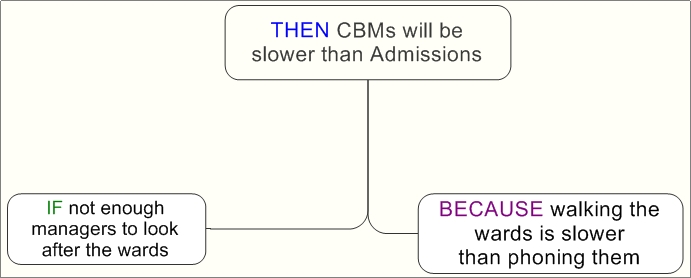“We All Fall Down” was a slow start until I started to come up to speed on the British health care system, the associated deep-rooted problems and the bottlenecks in the general hospital system. I did not know the one single factor in keeping hospitals from serving the next patient is shortage of beds. As you can imagine, the brilliant problem-solvers who are quick to jump to conclusion suggest none other than getting more beds! In the span of 353 pages, the authors reveal Goldratt’s Theory of Constraints (TOC) into practice and show us in the process why more beds only creates more problems.
Our main character, Beth, is funny, tough and determined, and she heads the Clinical Bed Administration office, or Admissions for short. Her mantra is this: “We all want to do a good job”, one she repeats over and over as one does with a good mantra. Fed up with the current management and decision makers, she slowly creates an effort to take on an enormous task – that of drastically improving the way the British health care operates at its core. As I am not at all familiar with the British Health care system, I am not qualified to comment on the level of accuracy of this book’s articulation of it. I think the authors do well in setting up a decent story by means of which to teach us about TOC.
Beth knows the situation has not improved with more beds. The hospital is overflowing, and they cannot serve all the patients in time. She sets on a journey to educate herself by looking to her brother-in-law, Harry. Harry lives in the US and is a successful follower of TOC. The background story is not significant, even as I wished for a better one – it is a business novel intended to make the abstraction less abstract, and the solutions more memorable. The first concept Harry teaches Beth is familiar to some of us: Focus on the weakest link in the chain. Beth grasps this very quickly and starts to put it to practice, despite the resistance and cynicism she faces in the hospital. It is very encouraging to watch Beth go about this task armed with just her newly grasped theories of TOC, and her faint glimmer of hope for the big change.
To give you a quick example on how to apply Theory of Constraints, imagine the following:
- Always ask the people who do the real work to comment on the project, keeping their comments to one phrase at a time, done over a few rounds.
- Gather all thoughts.
- Rephrase the questions into UDE (UnDesirable Effect) statements. For example:
Before: Will the nurse be notified?
After: The nurse will not be notified (UDE) - Then from the list of all such statements, take 2 of the UDEs and add a ‘because’ using boxes (see below)
Beth’s group, the admissions, was in charge of managing which bed to make available where, to what doctors and for what patients. In order to help them with the current shortage of beds, the management, guessing at the root cause and similarly at the solution, decided to allocate a group of expert nurses to Beth’s group; these were the Clinical Bed Managers (CBMs). In this example, our 2 UDEs are:
1. CBMs will be slower in performance than Admissions
2. There will not be enough managers left to look after the wards
{If, then, because clause }: IF there aren’t enough managers to look after the wards, THEN CBMs will be slower than admissions BECAUSE walking the wards is slower than phoning them.
Read another way:
{If, and, then clause}: IF there won’t be enough managers to look after the wards, AND walking the wards slower than phoning them THEN CBMs will be slower than admissions.
Image: A visual representation of the break-down for our problem statement. Created by Mindjet MindManager application.
Next, we need to add this to all the UDEs gathered in the discussion and try to connect them in such a manner. Then look for one UDE that does not fit anywhere; it feeds into all other problems but nothing feeds into it. This we will call UDE’ (UDE Prime). That is the core problem.Then use a cloud to represent the UDE and UDE’ (prime) — the opposite and desired situation, all feeding into the end goal. UDE and UDE’ are complete opposites.
For each UDE, follow this thought process and answer 3 questions:
1) What to change?
2) What to change to?
3) How to change it?
Example: IF admissions must act in best interest of the patients, THEN they must use their expertise, BECAUSE CBMs do not know how the system works.
In the diagram, we make sure D & D’ are opposites and B and C are incompatible.
The core problems according to Beth summarize to the following:
- Management does not listen to the staff.
- The reason for this is they do not know how much the staff knows.
- There is no platform for the staff in which to raise and address negatives effectively.
The book applies the Theory of Constraints to a real situation on a massive scale, with first half of the book spent on getting to the core of the problem and the last half, implementing the solution and convincing the right stakeholders of the right approach.
Reading is the best pastime for an active mind! If you like to see the other book reviews, check the index of In Print.
In the course of learning about Goldratt’s Theory of Constraints, we also get a glimpse of the seven layers of resistance that we are likely to face from the user community:
0: I don’t accept your agenda
1: I don’t agree that the problem is what you are saying
2: I don’t agree that the solution you are presenting is going in the right direction to get us a workable answer
3: I don’t accept that the benefits you claim your solution will bring actually materialize
4: I think there are possible negative side effectives from your proposed solution
5: I don’t believe we can overcome the obstacles that your proposed plan will encounter on the way
6: I said “yes” but I won’t move — we have an abused past — “who are you to talk to me about my area of expertise?”
There are 5 focusing steps of constraint management:
Identify, Exploit, Subordinate, Elevate, Repeat
We have to understand what we do now in order to be able to decide upon what we should be doing in the future, and until we know this, we cannot possibly know how to change.
I loved this book. I would give it a solid 5 rating on a 1-5 scale. Even so, I was very frustrated and disappointed at the endless number of punctuation, grammar, and other similar English language errors that the publishers had made. This was not an unrevised version or an early copy but a final edition. It would benefit from running through a competent editor for redeeming the respect of the material.


 I am Farnoosh, the founder of Prolific Living. So glad you are here. My mission is to empower you to unblock your creative genius to live your dream life.
I am Farnoosh, the founder of Prolific Living. So glad you are here. My mission is to empower you to unblock your creative genius to live your dream life.